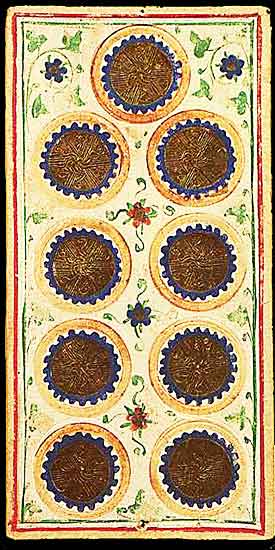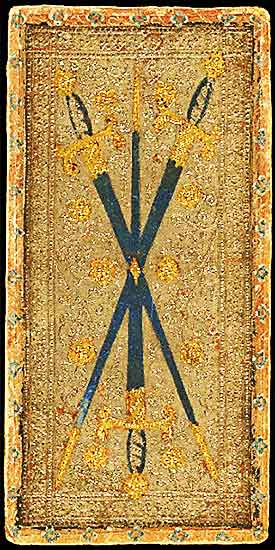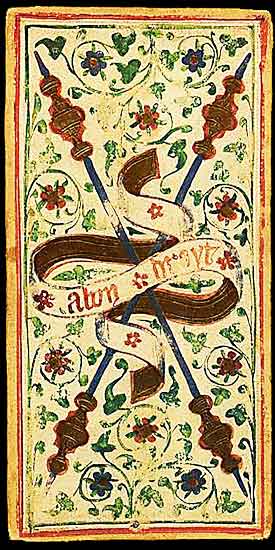The Three Pyramids Spread

Difficulty: Complicated
Basically, there is the main pyramid in the centre, and two smaller pyramids on each side. One is inverted.
Positions 1 & 3 represent where the reader comes from, or what has made them/shaped them on the various levels. Can be from environment, upbringing, schooling, etc. A look at the past, but with more objectivity than is usually given when using tarot cards.
Positions 4 & 5 represent who the reader is right now. May or may not make pleasant reading, but hey, this is what this is about, right?
Position 6 represents who the reader could be. Again, it might or might not look good, but a person can learn from that and change who they are accordingly. (This is a bit like how Scrooge did things in 'A Christmas Carol'.)
Positions 7 & 8 are the reader's strengths. This is the light they have, which can be bought to the forefront. What carries the person should not be hidden or unacknowledged.
Position 9 represents what should be given to oneself or created within.
Position 10 & 11 represent personal areas for development or weaknesses. Again, might not make good reading, but if someone looks at their strengths first, they will be able to see a balance is there and can choose to focus on one side or the other. This is where a person could really see how their shadow side comes into play.
Position 12 represents what the reader should be offering externally, or what they can bring to their world or to others who inhabit that world.
Your Three Pyramids Reading
Strength #1 |
Strength #2 |
 |
Exhibit |
|||
Nurture This |
Potential |
Infirmity #1 |
Infirmity #2 |
|||
Now #1 |
Now #2 |
|||||
Base (past) #1 |
Base (past) #2 |
Base (past) #3 |
1: Base #1

The Three of Swords represents heartbreak, emotional pain, and sorrow. It signifies a time of emotional distress or grief, often stemming from betrayal, rejection, or loss. This card highlights the painful but necessary process of healing and moving through emotional challenges.
Symbolism: The three swords crossing reflect the pain of emotional betrayal or hurt. The inverted triangular formation emphasises the gravity of the situation, drawing attention to the emotional core. The stark simplicity of the design reinforces the rawness of emotional distress.
In Relationships: Heartbreak or emotional turmoil caused by separation, betrayal, or unrequited love. The Three of Swords encourages you to face your pain and allow yourself time to heal.
In Work: Disappointments or challenges in your professional life. This card can represent a painful decision or the end of an important chapter.
Spiritually: A time of spiritual grief or disillusionment. The Three of Swords invites you to process your emotional wounds and trust in the healing process.
When ill-dignified: Holding onto hurt or bitterness. The Three of Swords warns against allowing emotional pain to define you or inhibit growth.
2: Base #2

The Knight of Swords represents action, determination, and intellectual pursuit. This card signifies a person driven by mental clarity and purpose. The Knight of Swords charges forward with a clear objective, often at breakneck speed.
Symbolism: The charging horse and dynamic posture emphasise forward motion and energy. The detailed armour reflects the Knight's preparedness, while the ornate background suggests formality and purpose.
In Relationships: Quick action or intense passion. The Knight of Swords suggests taking decisive steps or charging ahead confidently, but it may also warn against rushing into things.
In Work: A period of fast-paced action or a challenge that requires quick thinking and decisiveness. This card represents the need to act swiftly in your career.
Spiritually: A time of mental clarity and forward motion in your spiritual journey. The Knight of Swords calls you to act on your insights and take bold steps towards spiritual growth.
When ill-dignified: Impulsiveness, recklessness, or aggressive behaviour. The Knight of Swords warns against rushing forward without considering the consequences.
3: Base #3

The Two of Staves symbolises duality, decision-making, and the balancing of forces. It represents a time when a choice must be made, but the way forward is clear only through contemplation and internal balance.
Symbolism: The two staffs, arranged symmetrically, reflect the concept of partnership, opposition, or balance. The delicate flourishes at the bases suggest that, though the decision may be significant, it need not be rushed. The flowery background continues the theme of elegance, inviting you to focus on the inner dynamics between opposing forces.
In Relationships: A decision lies ahead—whether to commit, balance differences, or choose a path together. This card invites careful deliberation before taking action.
In Work: A time to evaluate your options, whether expanding your horizons or staying the course. It speaks to the importance of balancing ambition with patience.
Spiritually: The Two suggests an inner conflict or a need to find balance within yourself. This card encourages introspection and a search for harmony.
When ill-dignified: Indecision, imbalance, or the inability to make a clear choice. You may be stuck in a state of conflict, unable to resolve opposing forces in your life.
4: Where you are now #1

The Nine of Cups represents emotional contentment, satisfaction, and the fulfilment of desires. It indicates a time of emotional happiness and the realisation of personal goals.
Symbolism: The nine chalices are arranged in a grid, symbolising balance and fulfilment. Their elaborate designs reflect the richness of the emotional experience, while the uniformity of the arrangement suggests completeness and stability.
In Relationships: Emotional fulfilment and contentment. This card signifies the realisation of romantic dreams or a period of joy and connection with a partner.
In Work: Professional satisfaction and the achievement of goals. The Nine of Cups represents a time of success and personal accomplishment in your work life.
Spiritually: Emotional harmony and spiritual fulfilment. The Nine of Cups invites you to celebrate your spiritual achievements and the peace you've cultivated.
When ill-dignified: Complacency, overindulgence, or taking things for granted. The Nine of Cups warns against resting on your laurels or neglecting personal growth.
5: Where you are now #2

Strength symbolises courage, patience, and the mastery of inner power. It reflects the triumph of compassion and self-control over brute force.
Symbolism: The figure's calm restraint of the lion reflects the balance of strength and gentleness. Her finely detailed garments and the rendering of the lion's mane reflect Renaissance artistry, while the golden background elevates the scene to a symbolic level.
In Relationships: A time to practise patience and understanding. Strength signals harmony through compassion.
In Work: Success through persistence and confidence. Strength encourages inner resolve rather than aggressive tactics.
Spiritually: Strength represents mastering the ego and cultivating inner peace through compassion.
When ill-dignified: Aggression, self-doubt, or weakness. It warns against succumbing to fear or forceful behaviours.
6: Your potential

The Sun represents vitality, clarity, and joyful achievement. It signifies success, enlightenment, and the unyielding energy of optimism and truth.
Symbolism: The child holding the radiant red head is a symbol of pure, untainted joy and triumph. The energetic movement of the figure contrasts with the calm, golden background, reflecting the vitality and dynamic energy of the Sun. This is a card of achievement, where obstacles are overcome through innocence, optimism, and a radiant spirit.
In Relationships: The Sun brings clarity and happiness. It suggests a time of positivity, joy, and mutual growth, where the light of truth shines on all interactions.
In Work: Success and fulfilment are on the horizon. The Sun encourages you to take confident action and bask in the warmth of your accomplishments.
Spiritually: Enlightenment and clarity. The Sun symbolises spiritual illumination, urging you to embrace your true self and the divine light within you.
When ill-dignified: Overconfidence, arrogance, or an inability to see things clearly. The Sun reversed may signal excess or an inflated ego, blinding one to the truth.
7: Strength #1

The Queen of Coins represents nurturing, abundance, and practical wisdom. She is a motherly figure who embodies warmth, security, and the ability to create a stable and prosperous environment for others. This card speaks to a balance of generosity, practicality, and a grounded approach to material wealth.
Symbolism: The Queen's regal yet nurturing posture, along with her detailed gown and the coin she holds, reflects her ability to create abundance through care, planning, and attention to detail. The golden tapestry symbolises wealth and elegance.
In Relationships: A loving, supportive partner who creates a warm, stable home. The Queen of Coins encourages a relationship rooted in care, nurturing, and shared prosperity.
In Work: A grounded, practical approach to career success. The Queen of Coins suggests using your skills to create financial security for yourself and others.
Spiritually: Spiritual abundance through nurturing practices. The Queen of Coins advises using your spiritual wisdom to care for yourself and others.
When ill-dignified: Over-protection, possessiveness, or neglecting your own needs for the sake of others. The Queen of Coins warns against being controlling or too focused on material wealth.
8: Strength #2

The Nine of Coins represents self-sufficiency, abundance, and material comfort. It signifies a time of enjoyment, where hard work has paid off, and you can enjoy the fruits of your labour. This card celebrates the pleasures of luxury, refinement, and personal achievement.
Symbolism: The stacked arrangement of nine coins reflects abundance and harmony. The stable design conveys accomplishment, stability, and satisfaction.
In Relationships: A relationship that is self-sufficient and fulfilling. The Nine of Coins suggests enjoying the fruits of love and mutual respect, with a sense of independence.
In Work: Financial success and personal achievement. This card represents enjoying the rewards of your hard work and attaining a comfortable, stable position in your career.
Spiritually: Fulfilment and the joy of having reached a place of peace and abundance in your spiritual journey.
When ill-dignified: Over-indulgence, isolation, or dependence. The Nine of Coins warns against relying too heavily on material comforts or becoming disconnected from others.
9: Nurture this

The Star is the card of hope, inspiration, and divine guidance. It signals a time of clarity and renewal, where one is aligned with their highest potential and the energies of the universe.
Symbolism: The woman beneath the large, radiant star symbolises divine connection and the flow of universal wisdom. Her upward-reaching arms indicate a yearning for enlightenment or higher understanding, while her delicate robes and the shimmering golden backdrop suggest purity, healing, and inspiration. The simplicity of the composition focuses on the power of the celestial symbol above, offering a vision of clear direction.
In Relationships: A time of healing and optimism. The Star signals hope for the future of a relationship, inspiring trust and a deep connection between partners.
In Work: Clarity and insight bring success. The Star indicates that inspiration and divine guidance will lead you towards the right path.
Spiritually: A card of spiritual renewal, the Star calls you to reconnect with your higher self and seek inspiration from the divine.
When ill-dignified: Delusion, disillusionment, loss of hope, or a feeling of being disconnected from your higher purpose. This warns against losing sight of your spiritual or personal goals.
10: Weakness #1

The Seven of Coins represents patience, investment, and assessment. It signifies a time to step back and evaluate the progress of your efforts. This card emphasises the importance of patience and the need to wait for the fruits of your labour to manifest.
Symbolism: The irregular arrangement of the seven coins suggests growth, progress, and the anticipation of results. Their grouping represents the natural rhythm of growth, with some efforts taking longer to bear fruit than others.
In Relationships: Reflecting on the progress of a relationship and taking stock of where things are headed. The Seven of Coins encourages patience and careful assessment before making major decisions.
In Work: Evaluating your career progress and investments. This card advises you to assess the returns of your efforts, as growth may be gradual.
Spiritually: A time of spiritual assessment, where you evaluate your progress on your path. The Seven of Coins encourages patience and trust in the process.
When ill-dignified: Impatience, frustration, or lack of faith. The Seven of Coins warns against rushing or abandoning your efforts prematurely.
11: Weakness #2

The Seven of Swords represents secrecy, deception, and strategy. It speaks to situations where you may feel the need to be clever, sneaky, or evasive to get what you want. This card can indicate an act of stealth or even betrayal, but it also highlights the need for careful planning and discretion.
Symbolism: The unbalanced arrangement of the swords suggests movement, stealth, and uncertainty. The overlapping blades hint at hidden motives or the complexity of a situation that requires more than just straightforward action.
In Relationships: Hidden agendas or deception. The Seven of Swords advises caution, as someone may not be entirely honest with you or you may be hiding something.
In Work: Strategic planning or taking calculated risks. The Seven of Swords can suggest that you are working behind the scenes to achieve your goals, but caution is needed to avoid deceit.
Spiritually: Secrets or hidden truths within your spiritual path. This card encourages you to examine any areas where dishonesty or avoidance might be hindering your growth.
When ill-dignified: Betrayal, dishonesty, or evasion. The Seven of Swords warns against deceitful actions or neglecting the truth for personal gain.
12: Behavior to exhibit

The Hermit symbolises introspection, solitude, and the search for wisdom. He represents the retreat from worldly distractions to find enlightenment within.
Symbolism: The Hermit's lantern lights the way, symbolising inner guidance. His heavy robes and staff reflect humility and steadfastness, while the muted tones and golden accents emphasise the sacred nature of his solitary journey.
In Relationships: A period of introspection. The Hermit may suggest a need for space or reflection before moving forward.
In Work: Time to step back and assess your goals. The Hermit advises seeking clarity and wisdom before making decisions.
Spiritually: The Hermit represents the inner search for truth and enlightenment through meditation and solitude.
When ill-dignified: Isolation, withdrawal, or a refusal to seek help. It warns against becoming too introspective or disconnected.